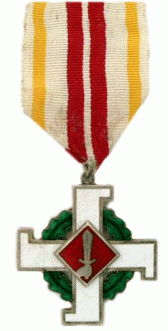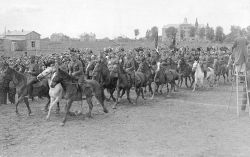The Aizsargi or Civil Guard organization1 was founded March 30, 1919 as a civic obligation of rural inhabitants. Its initial purpose was to protect lives and property from criminals and Bolshevik partisans as the front line against Bolshevik Russia eventually advanced in the War of Independence. They performed guard duties on major roads and otherwise aided in police duties. The guard was lightly armed, primarily with captured arms unsuitable for army use. By 1920, virtually all parish2 residents summoned to service had joined its various regiments, which were organized by county.
With peace achieved in 1920, the Aizsargi transitioned to voluntary state service. It was formally reorganized, reporting to the Ministries of Interior and War. Although their primary mission was one of military readiness, they also played a significant role in community life throughout their existence, organizing, hosting, and participating in a wide range of events and activities.
The Aizsargi continued to grow in membership and involvement in civic life throughout Latvia's first period of independence. They have been widely represented as the military force which overthrew the government in support of Kārlis Ulmanis's coup d'état of 1934. In reality, the army and police executed the coup. The Aizsargi's reputed prominence in executing the coup grew out of subsequent propaganda, both on the part of the Ulmanis regime to emphasize popular support3; later, on the part of the Soviet Union, denouncing Ulmanis and all who supported him as fascists.
Upon Soviet occupation of Latvia in 1940, the Aizsargi organization was abolished and many of its members killed or deported, including the vast majority of its leadership.
Today, the origins and positive contributions to community life of the Aizsargi have been swept away in a deluge of falsehoods:
- labeling the Aizsargi a fascist and anti-Semitic organization from its very inception;
- equating the Aizsargi with Latvia's extremist fascist (not Nazi) political organization, the Pērkonkrusts, founded in 1933—and outlawed by the Ulmanis regime after his coup; and
- alleging the Aizsargi independently conducted extermination pogroms against Jews before Nazi Germany completed its invasion of—and organization of the Holocaust on—Latvia's territory.
Our purpose
Membership in the Aizsargi was a matter of duty, civic involvement and community pride. The Aizsargi were more than a peace time militia. They organized sporting competitions, cultural exhibitions, concerts, plays and literature readings, and more—the county (apriņķis) Aizsargi Hall was the center of community life. Our hope is to restore that pride to all those whose forebears were aizsargi and aizsardzes4 and to dispel any shame they may feel for their Latvian heritage5—suffering the stigma born of a campaign of disinformation still waged today.
| 1 | "Aizsargs" (singular) simply means "guard"; the same word is used for the position of hockey or soccer goalie. Any more descriptive terms: home guard, national guard, civil guard,... are all at the discretion of the translator. We have chosen "civil guard" because the Aizsargi were patterned after the Finnish "civil guard," Suojeluskunta, founded in 1918. |
| 2 | Pagasts, or "parish" applies to localities in the same manner as in Britain. |
| 3 | Valters Ščerbinskis, Forgotten Pages in Baltic History: Diversity and Inclusion, Martyn Housden, David J. Smith, Eds. (Rodopi, 2011) 203 |
| 4 | Aizsargs and aizsardze masculine and feminine singular; aizsargi and aizsardzes masculine and feminine plural. |
| 5 | Latvians have denied their heritage to their own families, believing themselves to be the descendants of anti-Semites and murderers, viz. Latvian POWs, Still imprisoned by fabrications of history, retrieved 15-March-2014 |

